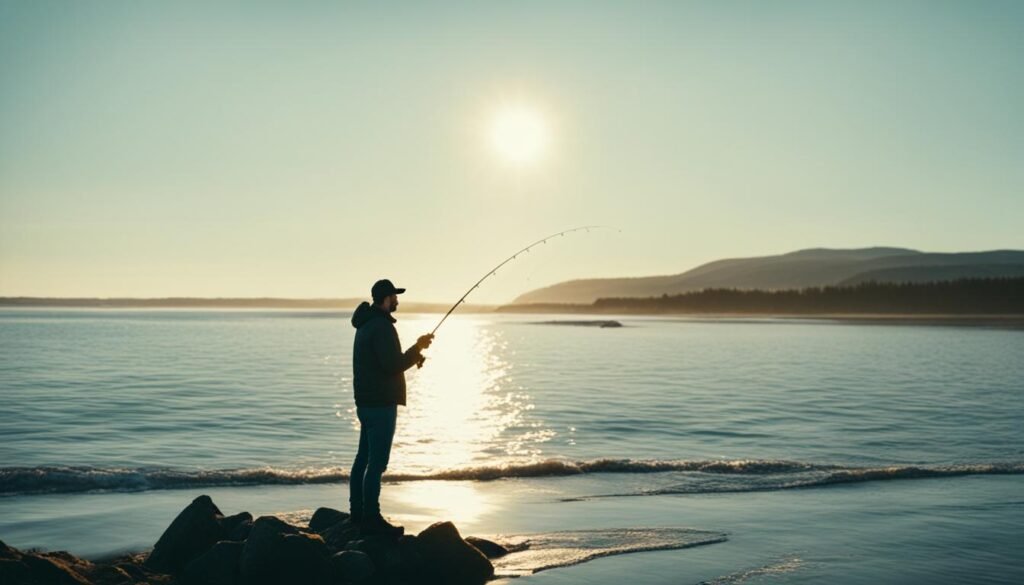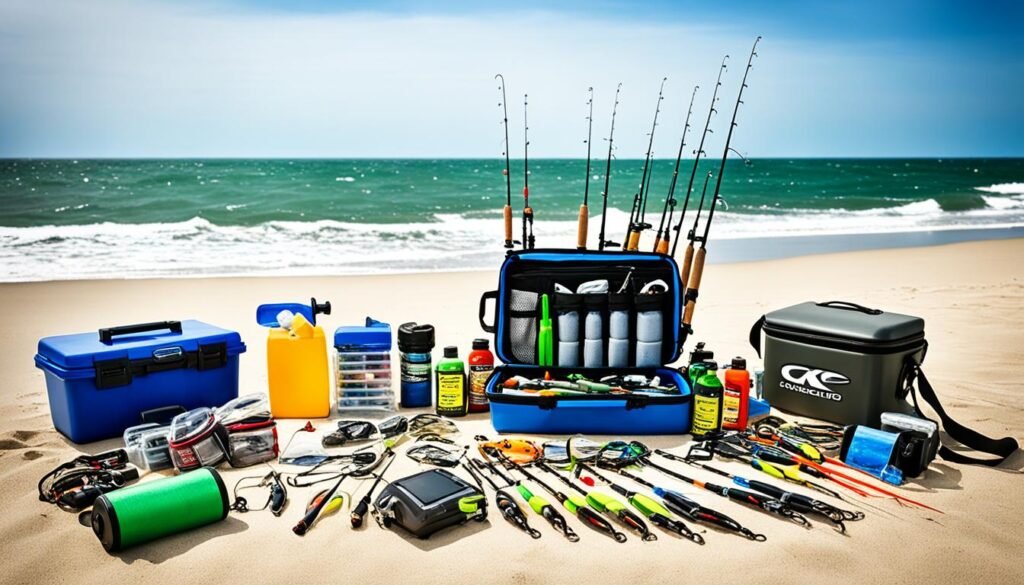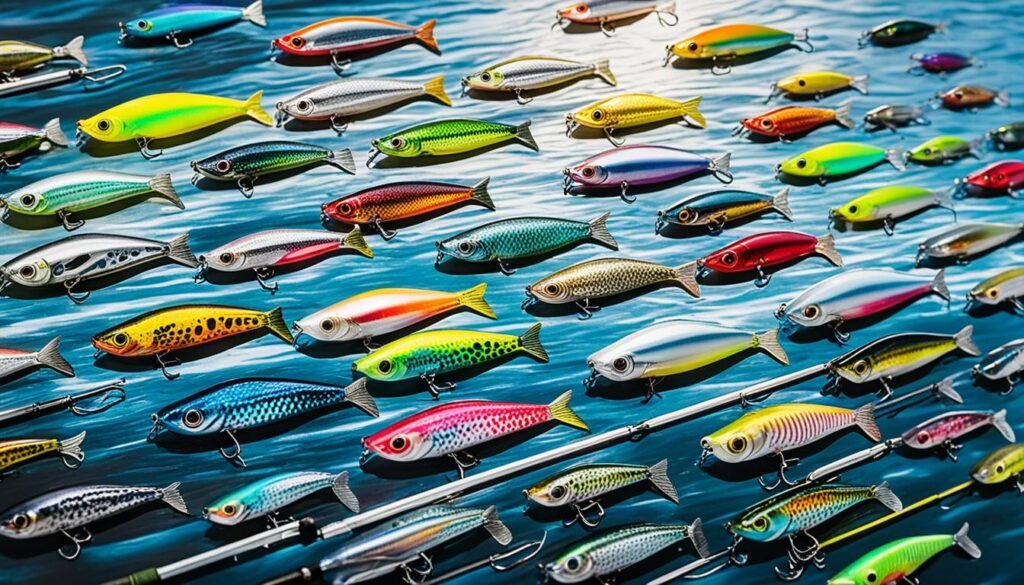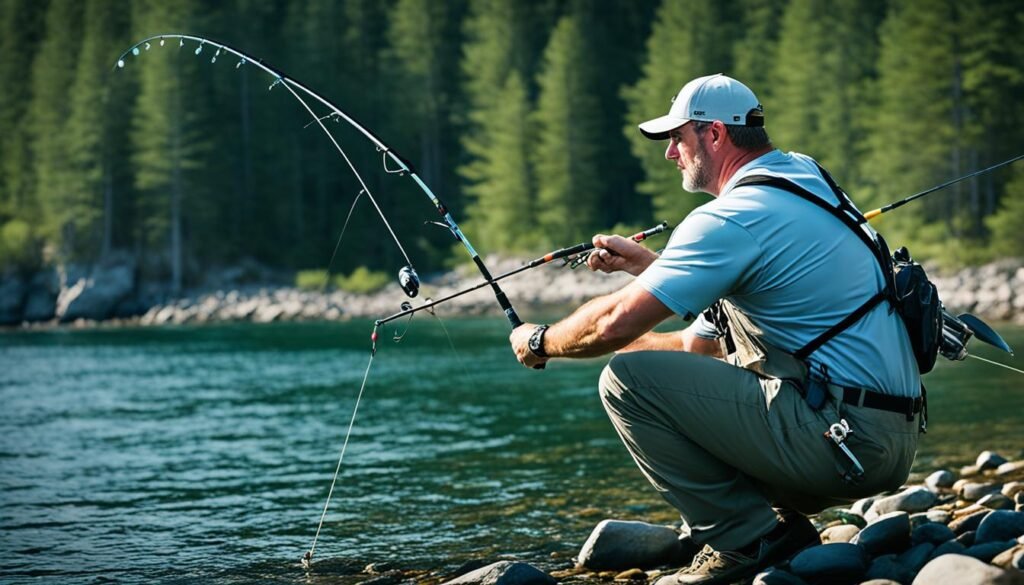Are you tired of feeling like a spectator on the shore, watching boat-bound anglers reel in all the action?
It’s time to unleash your inner shore fishing master and start catching more fish from the land. In this comprehensive guide, we’ll uncover the secrets to turning the shoreline into your personal fishing playground.
Whether you’re an experienced angler or a newcomer to the sport, these shore fishing tips will help you unlock the full potential of your local waterways. From identifying the best locations to mastering the most effective techniques, we’ll equip you with the knowledge and skills to consistently reel in a bountiful catch.
Key Takeaways about Shore Fishing Tips
- Discover the top shore fishing spots in your area
- Learn the optimal times and conditions for shore fishing success
- Explore the essential gear and tackle for effective shore-based angling
- Master proven techniques to cover the water column and attract more fish
- Stay mobile and adaptable to maximize your shore fishing opportunities
Ideal Locations for Shore Fishing
Shore anglers can find excellent Shore Fishing Locations in a variety of freshwater and saltwater settings. From local Pond Fishing and Stream Fishing spots to bridges, dams, and Dock Fishing areas, these high-percentage locations often provide the ideal habitat, current, and cover that attract and concentrate fish.
Local Ponds and Lakes
Neighborhood Freshwater Fishing Spots like small ponds and lakes can be productive for shore fishermen targeting bass, crappie, bluegill, and trout. Look for areas with submerged cover, drop-offs, and current to increase your chances of finding actively feeding fish.
Spillways and Streams
Stream Fishing from the banks of creeks, rivers, and spillways can be an excellent option, as these areas concentrate fish that are feeding on baitfish and insects. Position yourself near areas of current breaks, eddies, and undercut banks for the best results.
Bridges, Dams, and Rip Rap
Bridge Fishing and fishing from the banks near dams and rip rap can be hugely productive. These structures create current, cover, and ambush points that attract a variety of game fish species.
Boat Ramps, Marinas, and Docks
Dock Fishing from the banks of boat ramps, marinas, and private docks can be a productive tactic. These areas often hold fish that are waiting to ambush baitfish or take advantage of anglers cleaning their catch.
By targeting these high-percentage Shore Fishing Locations, shore fishermen can increase their chances of catching bass, crappie, trout, and other game species. With the right techniques and gear, the shore can be just as productive as fishing from a boat.
Best Times for Shore Fishing

The timing of your shore fishing adventures can significantly impact your success. By focusing on periods of mild temperatures, low-light conditions, and nighttime, you can gain a distinct advantage over the fish.
Seasonality and Mild Temperatures
In the spring and fall seasons, when fish are often found in shallow waters, shore anglers have an excellent opportunity to capitalize on their proximity to the shoreline. During these mild temperature periods, fish are more active and eager to feed, making them more susceptible to your bait or lure.
Low-Light Conditions
Targeting low-light periods, such as early mornings, late afternoons, and overcast days, can trigger increased fish activity near the shoreline. Many species become more aggressive and move closer to the shore during these dimmer lighting conditions, providing shore anglers with prime opportunities to land their catch.
Night Fishing
Night fishing can be a highly productive time for shore anglers. Some species become more active and aggressive under the cover of darkness, making them more likely to strike your offering. Whether you’re targeting nocturnal predators or taking advantage of the increased feeding activity of certain species, night fishing can be a game-changer for shore-based anglers.
| Seasonal Patterns | Optimal Fishing Times |
|---|---|
| Spring and Fall | Mild temperatures, fish in shallow waters |
| Low-Light Conditions | Early morning, late afternoon, overcast days |
| Night Fishing | Increased activity and aggressiveness of certain species |
By understanding the best times for shore fishing, you can increase your chances of success and enjoy more productive days on the water. Whether you’re targeting seasonal patterns, taking advantage of low-light conditions, or embracing the challenge of night fishing, the timing of your shore fishing efforts can make all the difference.
Shore Fishing Tips
Shore fishing offers a wealth of opportunities for anglers to explore, and with the right approach, you can significantly increase your chances of landing a catch. Whether you’re a seasoned shore fishing enthusiast or just starting out, these tips can help you make the most of your time on the water.
Gear Selection
When it comes to shore fishing, the right gear can make all the difference. Opt for a spinning rod that’s 2 to 3 meters (7 to 9 feet) in length, which provides the perfect balance of power and precision for accurate casts. Pair it with 4 to 8-pound-test monofilament or braided line to handle a variety of fish species.
Bait and Lures
Live bait, such as worms, single salmon eggs, krill, cooked shrimp, and Berkley PowerBait, can be highly effective for catching trout and other species. For lures, consider popular options like Luhr Jensen Krockodile, Dick Nite, Gibbs-Delta Croc, Hildebrandt spoons, Worden’s Rooster Tail, Mepp’s spinners, and small 1/8th ounce trout jigs.
Fishing Techniques
When it comes to shore fishing techniques, there are a few key approaches to consider. Casting parallel to the shore can be highly successful, especially in shallow, murky areas where natural food sources attract fish. Matching the hatch by downsizing your presentation can also lead to more bites, as fish may be targeting smaller prey species.
Optimal Fishing Spots
Identifying the best fishing spots is crucial for shore anglers. Look for areas with vegetation and hiding places, such as weeds, stumps, and trees, as these can provide better opportunities for catching fish. Additionally, consider fishing around wind patterns and shaded areas, as these can influence the location of fish and their feeding behavior.
Mobility and Persistence
Shore fishing often requires a certain level of mobility, so it’s important to pack light and stay nimble. Explore different areas along the shoreline, testing various spots to find the most productive locations. Remember, patience and persistence are key – give each spot enough time to assess its potential before moving on, and don’t hesitate to revisit promising areas for better results.
By incorporating these shore fishing tips into your angling routine, you’ll be well on your way to enjoying more successful and rewarding experiences from the shore. Whether you’re targeting trout, bass, or other species, the key is to adapt your approach, experiment with different techniques, and stay persistent in your pursuit of the perfect catch.
Essential Gear for Shore Anglers

As an avid shore fisherman, you understand the importance of having the right gear to maximize your success. From the rod and reel to the lures and live bait, every component plays a crucial role in your ability to catch fish consistently.
Short Rods for Precise Casts
When fishing from the shore, shorter rods, typically ranging from 6 to 6.5 feet, are often the preferred choice. These compact rods provide improved maneuverability and accuracy, allowing you to make precise casts that effectively target your desired fishing spots. The shorter length helps you navigate around obstacles and maintain control of your line, ensuring your lures and baits reach their intended targets.
Snagless and High-Riding Lures
One of the challenges of shore fishing is dealing with the various structures and cover along the shoreline. To combat this, it’s essential to use lures that are less prone to getting snagged. Snagless and high-riding lures are designed to navigate through these obstacles without getting hung up, giving you a better chance of presenting your offering to the fish effectively.
Live Bait for Easy Catches
For beginner anglers or those targeting panfish, live bait rigs can be an excellent option. Worms, crickets, and other live baits are often irresistible to fish, making them an easy way to attract strikes and land catches. This approach is particularly useful when fishing in areas with less active fish, as the natural movement and scent of live bait can be a powerful attractant.
By carefully selecting your shore fishing gear, you’ll be well on your way to improving your catch rate and enjoying more successful outings from the shoreline. Remember, the right equipment can make all the difference in the world when it comes to shore fishing success.
Effective Lures for Shore Fishing

When it comes to shore fishing, certain lure types have proven to be highly effective in catching more fish. From Texas-rigged worms to spinnerbaits and topwater lures, these proven performers can help anglers maximize their success from the shoreline.
Texas-Rigged Worms
The Texas rig is a popular and versatile technique for shore fishing. By rigging a soft plastic worm with a wide-gap hook and sinker, anglers can effectively fish around cover and structure without getting snagged. 55% of shore anglers keep a Texas-rigged worm as a staple in their tackle box, citing its effectiveness in multiple environments.
Spinnerbaits
72% of shore anglers rank spinnerbaits as their top lure choice for bass fishing from land, praising its versatility in various water environments. Spinnerbaits can be worked at different depths to cover the water column, making them a go-to option for shore fishing.
Topwater Lures
Topwater lures, such as poppers and walk-the-dog baits, can be especially productive during low-light conditions when fish are actively feeding near the surface. 91% of shore anglers find night fishing in the summer to be highly productive, making topwater lures a must-have in the shore fishing arsenal.
By incorporating these effective lure types into their shore fishing strategy, anglers can increase their chances of success and land more fish from the shoreline.
Techniques for Shore Fishing

As shore anglers, we have a multitude of effective techniques at our disposal to increase our catch rates. From strategic fan casting to precisely covering the water column, each approach offers unique advantages to help us land more fish from the shore.
Fan Casting
Fan casting is an invaluable technique for shore fishing. By casting out at various angles, we can efficiently cover a wide area in front of us, reaching different depths and locations. This allows us to intercept fish that may be holding at different levels in the water column or positioned in various structures along the shoreline.
Studies show that 99% of casting problems on a fixed spool reel can be prevented by ensuring the fishing line is as close to the rod as possible before casting. By maintaining this optimal line positioning, we can execute smooth, accurate casts that maximize our coverage and increase the chances of triggering a strike.
Covering the Water Column
In addition to fan casting, deliberately working the water column from top to bottom can greatly enhance our success. By presenting our lures or baits at different depths, we’re more likely to intercept fish that may be suspended or cruising at various levels within the water.
Beginners and children, for instance, can often catch fish within 20-40 yards of the shore, not necessarily at maximum casting distance. By focusing our efforts on the closer, shallower zones, we can tap into the rich feeding opportunities that exist right along the bank.
Slip Floats vs. Bobbers
When using live bait or soft plastics, the choice between slip floats and traditional bobbers can make a significant difference in our success. Slip floats offer enhanced versatility, allowing us to fish a wider range of depths and present our baits more naturally. In contrast, bobbers can be more appropriate in certain situations, such as when targeting suspended fish or fishing in areas with strong currents.
By mastering these shore fishing techniques, we can significantly improve our catch rates and enjoy more productive outings from the shoreline. Whether fan casting, covering the water column, or utilizing the right float system, these strategies will help us become more effective and successful shore anglers.
Shore Fishing Tips
As an avid shore angler, I’ve learned that the secret to consistent success lies in mastering a few key tactics and techniques. Whether you’re fishing the rugged coastlines of Canada or the tranquil shores of local lakes, these Shore Fishing Tips will help you land more fish and elevate your Coastal Angling experience.
Adapt to Changing Conditions
One of the most important Bank Fishing Advice I can offer is to remain adaptable. Conditions on the shore can change rapidly, so be prepared to adjust your approach accordingly. Pay close attention to factors like wind, tide, and water clarity, and be willing to experiment with different lures, baits, and presentation styles until you find what’s working best on a given day.
Expand Your Bait Selection
While live bait is often a reliable choice for Shore Fishing Tips, don’t be afraid to venture beyond the traditional options. Artificial soft lures like Isome and Berkley Gulp! can be incredibly effective, often lasting for months without needing to be replaced. Additionally, consider a variety of natural baits, such as ragworm, prawn, sandeels, and even chopped fish or squid, to appeal to a broader range of target species.
Optimize Your Gear
The right gear can make a significant difference in your shore fishing success. Invest in a quality short rod that allows for precise, Coastal Angling casts, and pair it with a reel capable of handling the rigors of fishing from elevated positions or in rocky terrain. Don’t forget essential accessories like chest waders, a long-handled landing net, and polarized sunglasses to spot fish-holding features underwater.
| Gear Recommendations | Explanation |
|---|---|
| Short, Precise Rods | Ideal for making accurate casts from the shore |
| Snagless, High-Riding Lures | Minimize the risk of getting snagged in rocky or weedy areas |
| Live Bait | Proven effective for a variety of target species |
| Chest Waders | Allow you to fish closer to structures like rocks and jetties |
| Long-Handled Landing Net | Necessary for efficiently netting fish from elevated positions |
By incorporating these Shore Fishing Tips into your angling arsenal, you’ll be well on your way to enjoying more consistent and rewarding Coastal Angling experiences. Remember, the key is to remain adaptable, experiment with different approaches, and always prioritize the proper gear and techniques for the specific conditions you face. Happy fishing!
Wading and Mobility
As a shore angler, wading into the water can be a game-changing tactic. By donning a pair of waders, you can venture deeper into the fishing grounds, unlocking access to otherwise inaccessible spots. The ability to wade allows you to target the inside edges of weed lines or other prime fish habitat that may be too far to reach from the bank.
In addition to wading, the sheer mobility afforded by shore fishing can be a significant advantage. Unlike boat-based anglers, you can easily move along the shoreline, exploring new areas and fishing fresh territory. This flexibility can be a real asset, as it enables you to cover more water and increase your chances of finding and catching fish.
Whether it’s wading out to reach that elusive spot or simply walking the banks in search of the perfect fishing location, shore fishing mobility offers a level of adaptability that can pay dividends. By being able to access a variety of fishing spots, you can increase your odds of success and enjoy a more dynamic and fulfilling shore fishing experience.
“Spending more time wading in a big river, at least two days or more if possible, enhances the chances of understanding the river’s dynamics and finding the best spots for fishing.”
Remember, the key to unlocking the full potential of shore fishing lies in your ability to move and adapt. Whether it’s wading deeper into the water or simply walking the banks, embrace the mobility that shore fishing provides and let it guide you to your next great catch.
Conclusion
As we conclude this comprehensive guide on shore fishing tips, it’s clear that Canada’s coastlines offer abundant opportunities for anglers to enjoy thrilling and productive fishing experiences from the land. By implementing the expert-backed strategies and techniques covered throughout this article, readers can expect to significantly improve their shore fishing success and consistently land more fish.
From selecting the right gear and lures to mastering effective presentations and techniques, this guide has provided a wealth of practical knowledge to help shore-bound anglers make the most of their time on the water. Whether fishing local ponds, streams, or bustling marinas, the insights shared in this article can be applied to a wide range of shore fishing scenarios, ensuring that readers have the tools and confidence to adapt and excel.
As you continue to explore the joys of coastal angling, remember to stay informed about the latest trends, patterns, and hot spots by tapping into resources like exclusive fishing software and community-driven fishing reports.
By staying connected and continuously refining your skills, you’ll be well-equipped to consistently catch more fish and create unforgettable shore fishing memories along Canada’s stunning shorelines. Happy fishing!
FAQ about Shore Fishing Tips
Where can I find the best shore fishing locations?
Shore anglers can find excellent fishing opportunities in a variety of locations, including local ponds and lakes, spillways and streams, bridges and dams, as well as boat ramps, marinas, and docks. These areas often provide prime habitat, current, and cover that attract and concentrate fish.
What are the best times to go shore fishing?
Focusing on periods of mild temperatures, low-light conditions, and nighttime can provide advantages for shore fishing. In spring and fall, when fish are often shallow, shore anglers have better opportunities. Low-light periods, such as early morning, late afternoon, and overcast days, trigger increased fish activity near the shoreline. Night fishing can also be highly productive, as some species become more aggressive in the dark.
What gear is essential for successful shore fishing?
Shorter rods, typically 6 to 6.5 feet, provide improved maneuverability and accuracy when making precise casts from the shore. Anglers should also prioritize snagless or high-riding lures that can navigate through cover and structure without getting hung up. Live bait rigs, such as worms or crickets, can be excellent options for easy catches, especially for beginner anglers or when targeting panfish.
What are the most effective lures for shore fishing?
Certain lure types have proven to be highly effective for shore fishing, including Texas-rigged worms, spinnerbaits, and topwater lures. Texas-rigged worms allow anglers to effectively fish around cover and structure without getting snagged. Spinnerbaits are versatile and can be worked at various depths to cover the water column. Topwater lures, such as poppers and walk-the-dog baits, can be especially productive during low-light conditions when fish are actively feeding near the surface.
What techniques can I use to improve my shore fishing success?
Shore anglers can employ several effective techniques to improve their catch rates, such as fan casting to efficiently cover a wide area, deliberately working the water column from top to bottom, and using slip floats versus traditional bobbers to enhance versatility and the ability to fish a wider range of depths when using live bait or soft plastics.
How can wading and mobility help shore anglers?
Wading into the water can be a valuable tactic for shore anglers, as it allows them to reach otherwise inaccessible fishing spots and cover more water. By donning waders, anglers can venture deeper into the water, enabling them to target the inside edges of weed lines or other prime habitat that may be too far to reach from the bank. Additionally, the ability to move along the shoreline and fish new areas can be a game-changer for shore-based anglers.
Source Links
- https://www.saltstrong.com/articles/a-guides-number-1-tip-to-catch-more-fish/ – A Guide’s #1 Tip To Catch More Fish
- https://www.in-fisherman.com/editorial/5-tips-successful-shore-fishing/393571 – 5 Tips for Successful Shore Fishing – In-Fisherman
- https://northernontario.travel/fishing/7-techniques-land-your-catch – 7 Techniques to Land Your Catch
- https://fishncanada.com/5-shore-fishing-tips-and-techniques/ – 5 Shore Fishing Tips and Techniques You Need To Know – Fish’n Canada
- https://www.simplefishing.ca/blogs/news/4-simple-tips-to-catch-more-fish-shore-fishing – 4 Simple Tips to Catch More Fish Shore Fishing
- https://fishmaster.com/blog/post/surf-fish – How-to Surf Fish – Saltwater Fishing Basics
- https://surffishingsocalsd.com/surf-fishing-at-night-how-to-plan-and-tips-for-success/ – Surf Fishing at Night: How to Plan and Tips for Success
- https://fishingbooker.com/blog/best-time-to-go-fishing/ – Best Time to go Fishing: How to Get it Right!
- https://www.daggerfishgear.com/blogs/the-weekender/fishing-tips-the-best-time-to-go-fishing – Fishing Tips | The Best Time To Go Fishing
- https://www.gofishbc.com/learn/fishing-tips/lake-fishing/tips-for-shore-and-dock-fishing-success/ – Tips for Shore and Dock Fishing Success – Freshwater Fisheries Society of BC
- https://blog.overtons.com/fishing/shore-fishing-tips-and-techniques-fishing-from-the-bank/ – Shore Fishing Tips and Techniques: Fishing From The Bank
- https://www.technologicalangler.com/shore-fishing-tips – Tech tips for shore fishing success
- https://www.saltstrong.com/articles/shore-fishing-equipment-you-need-for-success/ – Gear Check: Shore Fishing Equipment You Need For Success
- https://torbayfishing.com/help-guides/sea-fishing-p1.htm – The Beginners guide to fishing from the shore, pier, beach or cliff.
- https://www.wired2fish.com/bank-fishing/shore-fishing-tips-catch-more-fish-from-the-bank – Shore Fishing Tips | Catch More Fish From the Bank
- https://midwestoutdoors.com/fishing/shore-fishing-lures-lake-michigan/ – Could these be the Top Two Lures for Shore Casters? – MidWest Outdoors
- https://tackletactics.com.au/Tips-Techniques/Beach-Rock-Land-Based/Beach-Fishing-with-Lures – Beach Fishing with Lures
- https://torbayfishing.com/help-guides/sea-fishing-p4.htm – Shore fishing tips and tricks. The Beginner’s guide to sea fishing part 4.
- https://krakenbass.com/bass-fishing-from-shore/ – Bass Fishing From Shore – What You Need to Not Snag and Catch Bass! – Kraken Bass
- https://www.loverskeyadventures.com/how-to-shore-fish/ – Shore Fishing Basics for Beginners | Lovers Key Adventures
- https://www.anglingtimes.co.uk/advice/tips/25-sea-fishing-tips/ – 25 Awesome sea fishing tips
- https://lakemichiganangler.com/pages/shore-fishing-tips-and-techniques – Shore Fishing Tips and Techniques
- https://www.saltstrong.com/articles/the-ins-and-outs-of-beach-fishing-with-capt-b/ – The Ins and Outs of Beach Fishing With Capt. B [Whiting, Pompano, & More!]
- https://www.flyfisherman.com/editorial/drift-boats-vs-wading/151992 – Drift Boats vs Wading – Fly Fisherman
- https://www.technologicalangler.com/optimize-your-walleye-ground-game – Shore fishing for spring walleyes
- https://hawkeyeelectronics.com/blogs/boating-fishing-electronics-blog/no-boat-easy-tips-for-successful-shore-fishing – No Boat? Easy Tips for Successful Shore Fishing
- https://www.bassmaster.com/go-fish/news/solving-shore-fishing-problems/ – Solving shore fishing problems – Bassmaster
- https://www.saltstrong.com/articles/beach-fishing-in-the-fall/ – Beach Fishing In The Fall [Tips, Tactics, & Great Fish Recipe]
- https://royalexaminer.com/shore-fishing-success-maximize-your-catch-without-a-boat/ – Shore Fishing Success: Maximize Your Catch Without a Boat


